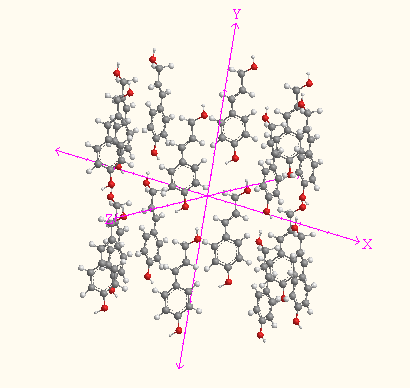COMPUTER SIMULATION OF THE POROUS STRUCTURE OF HYDROLYSIS LIGNIN AND ITS HARD COMPO-SITES WITH COMPONENTS OF OIL FUELS AND WATER
Abstract
A fragment of the supramolecular structure of lignin was simulated by cross-linking the C546H600O196 structural units along the corresponding CH–bonds followed by geometric optimization by the Polac-Ribier’s conjugate gradient method in the MNDO field of the HyperChem 8.0 software and ChemBio 13.0. The pore structure of lignin was simulated as well with optimization by the molecular mechanic’s method according to the MM2 Norman-Alinger’s algorithm taking into account the dipole-dipole interaction. Сoumaric alcohol molecule was a building block. The calculation of the energy parameters of lignin’s pore structure filling by the molecules of organic substances and water were carried out. It included a search for a global minimum of the potential energy by the molecular mechanic’s method according to the MM2 program and by the molecular dynamics method. The calculation had its basis in the “closed” pores existence in lignin. The calculated values of pore volume and specific surface area correlate with the experimental data. The way of prediction of organic substances sorption activity to lignin was proposed. This is evident from their calculated hydrophobicity parameter that correlates with the interaction energy of the molecules in the lignin pore.
Downloads
Metrics
References
Brauns F.E., Brauns D.A. The chemistry of lignin, New York; London, 1960, 804 p.
Flory P.J. Principles of рolymer сhemistry, New York, 1953, 672 р.
De Zhen P. Idei skeylinga v fizike polimerov. [Ideas of scaling in polymer physics]. Moscow, 1982, 368 p. (in Russ.).
Kokorevics A., Gravitis J., Ozol'Kalnin V. Khimiya drevesiny, 1989, no. 1, p. 324. (in Russ.).
Karmanov A.P., Monakov Yu.B. Uspekhi khimii, 2003, vol. 72, no. 8, pp. 797–819. (in Russ.).
Russell W.R. et al. Archives of biochemistry and biophysics, 1996, vol. 332, no. 2, pp. 357–366, DOI: 10.1006/abbi.1996.0353.
Heller W. International Symposium on Natural Phenols in Plant Resistance, 1993, vol. 381, pp. 46–73. DOI: 10.17660/ActaHortic.1994.381.2.
Eriksson Ö., Goring D. A.I., Lindgren B.O. Wood science and technology, 1980, vol. 14, no. 4, pp. 267–279.
Nie M., Huo S., Kong Z. Chemistry and Industry of Forest Products, 2010, vol. 5, pp. 1–27.
Ozolin'-Kalnin V.G., Gravitis Ya.A., Veyde F.G., Kokorevich A.G. Khimiya drevesiny, 1985, no. 1, pp. 108–109. (in Russ.).
Savitskaya T.A., Reznikov I.V., Shcheglov V.A., Tsygankova N.G., Telysheva G.M., Grinshpan D.D. Inzhenernofizicheskiy zhurnal, 2012, vol. 85, no. 3, pp. 611–616. (in Russ.).
Spessard G.O. Journal of chemical information and computer sciences, 1998, vol. 38, no. 6, pp. 1250–1253, DOI: 10.1021/ci980264t.
Nimz H. Angewandte Chemie International Edition in English, 1974, vol. 13, no. 5, pp. 313–321.
HyperChem R. 7.51 for Windows – Molecular Modeling System. Hypercube, USA, 2005.
Chem3D. CambridgeSoft Corporation, Cambridge, Massachusetts, USA, 2008.
Drugov Yu.S., Rodin A.A. Ekologicheskiye analizy pri razlivakh nefti i nefteproduktov, Moscow, 2007, 270 p. (in Russ.).
Jeon J.W. et al. ChemSusChem, 2015, vol. 8, no. 3, pp. 428–432, DOI: 10.1002/cssc.201402621.
Repnikova Ye.A., Aleshina L.A., Glazkova S.V., Fofanov A.D. Khimiya rastitel'nogo syr'ya, 2004, no. 1, pp. 5–9. (in Russ.).
Carrott P.J.M. et al. Carbon, 2010, vol. 48, no. 14, pp. 4162–4169, DOI: 10.1016/j.carbon.2010.07.031.
Vainio U. et al. Langmuir, 2004, vol. 20, pp. 9736–9744, DOI: 10.1021/la048407v.
Wang W. et al. BioMed Research International, 2016, article ID 8568604, 7 p. DOI: 10.1155/2016/8568604.
Singh G. et al. Carbon, 2017, vol. 116, pp. 448–455, DOI: 10.1016/j.carbon.2017.02.015.
Zhang Y., Wang A., Zhang T. Chemical Communications, 2010, vol. 46, no. 6, pp. 862–864, DOI: 10.1039/B919182H.
Sevilla M., Fuertes A.B. Carbon, 2009, vol. 47, no. 9, pp. 2281–2289, DOI: 10.1016/j.carbon.2009.04.026.
Zhao Z. et al. Journal of Materials Chemistry A, 2015, vol. 3, no. 29, pp. 15049–15056, DOI: 10.1039/C5TA02770E.
Foo K.Y., Hameed B.H. Bioscience Techn., 2012, vol. 111, pp. 425–432, DOI: 10.1016/j.biortech.2012.01.141.
Mičič M. et al. Scanning, 2000, vol. 22, no. 5, pp. 288–294, DOI: 10.1002/sca.4950220503.
Zou Y., Han B.X. Adsorp. Sci. Technol., 2001, vol. 19, pp. 59–72, DOI: 10.1260/0263617011493971.
Beletskaya M.G., Bogdanovich N.I., Kuznetsova L.N., Savrasova Yu.A. Izvestiya vuzov. Lesnoy zhurnal, 2011, no. 6, pp. 125–132. (in Russ.).
Beletskaya M.G., Bogdanovich N.I. Khimiya rastitel'nogo syr'ya, 2013, no. 3, pp. 77–82. (in Russ.).


This work is licensed under a Creative Commons Attribution 4.0 International License.
The authors, which are published in this journal, agree to the following conditions:
1. Authors retain the copyright to the work and transfer to the journal the right of the first publication along with the work, at the same time licensing it under the terms of the Creative Commons Attribution License, which allows others to distribute this work with the obligatory indication of the authorship of this work and a link to the original publication in this journal .
2. The authors retain the right to enter into separate, additional contractual agreements for the non-exclusive distribution of the version of the work published by this journal (for example, to place it in the university depository or to publish it in a book), with reference to the original publication in this journal.
3. Authors are allowed to post their work on the Internet (for example, in a university repository or on their personal website) before and during the review process of this journal, as this may lead to a productive discussion, as well as more links to this published work.











